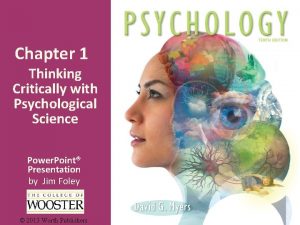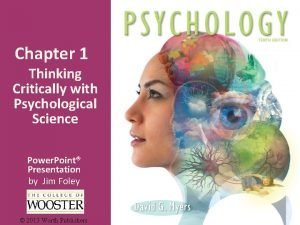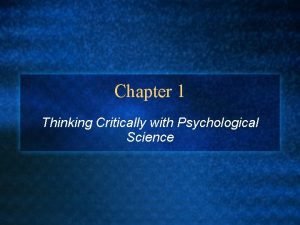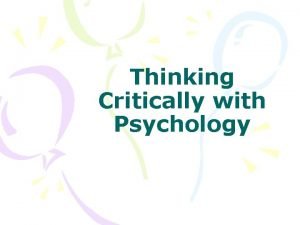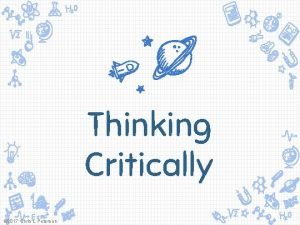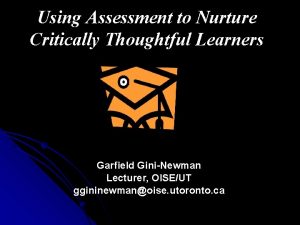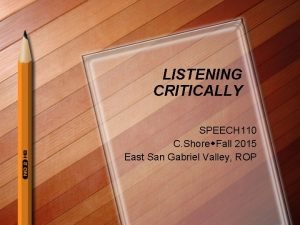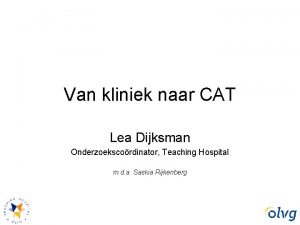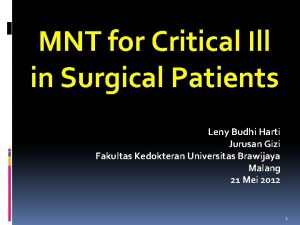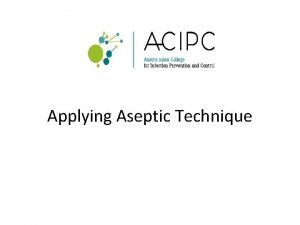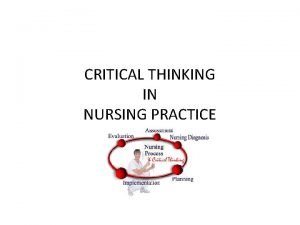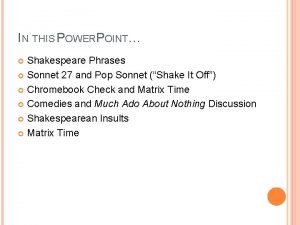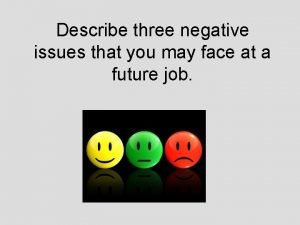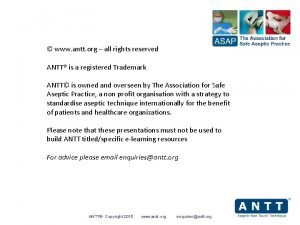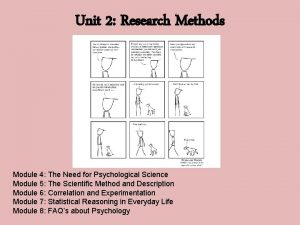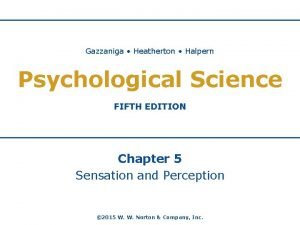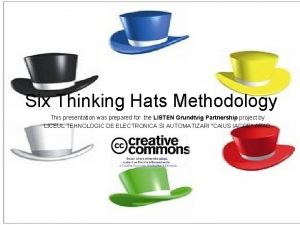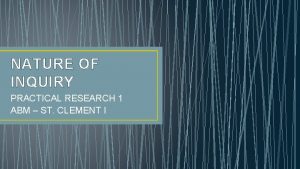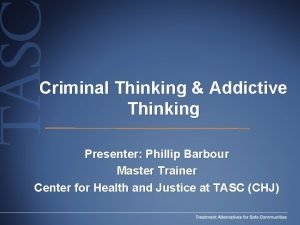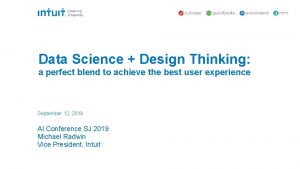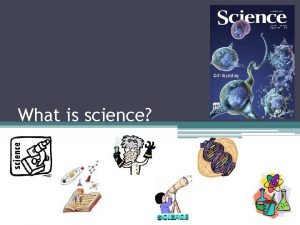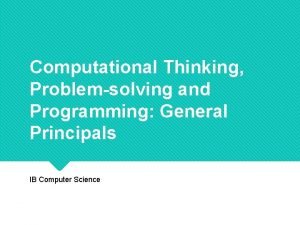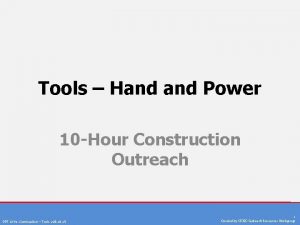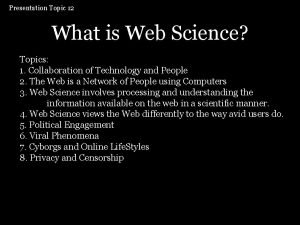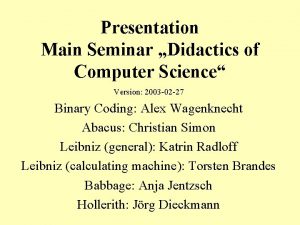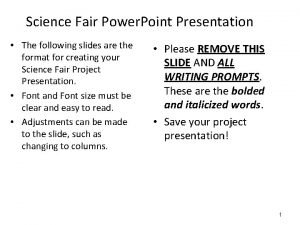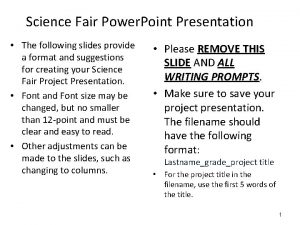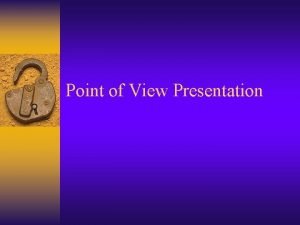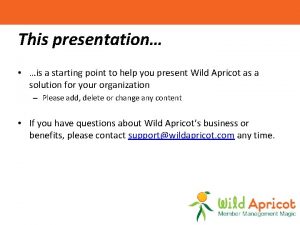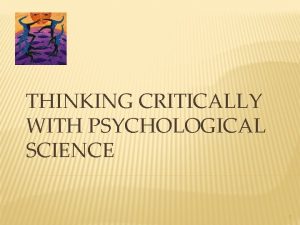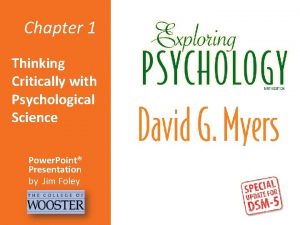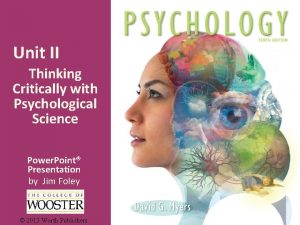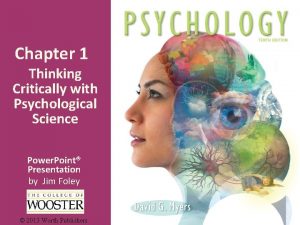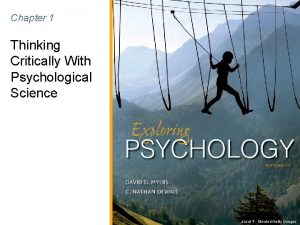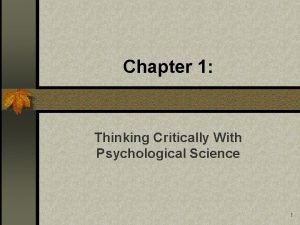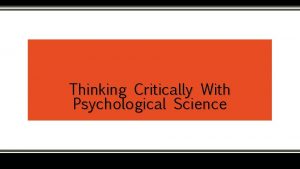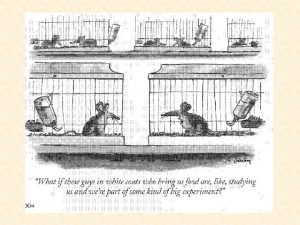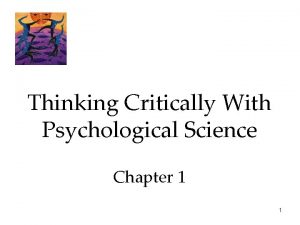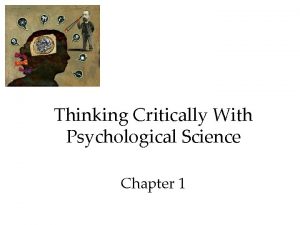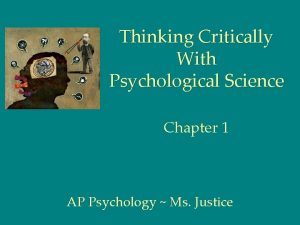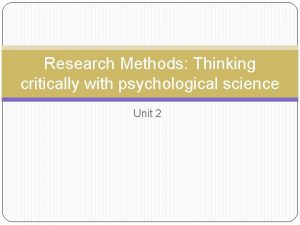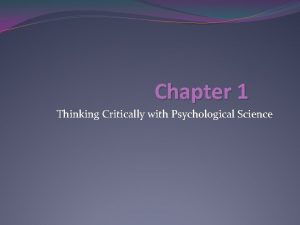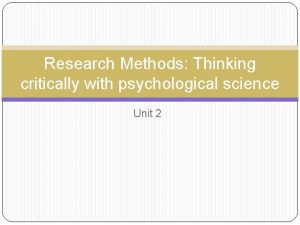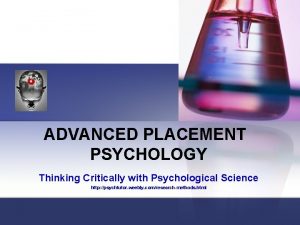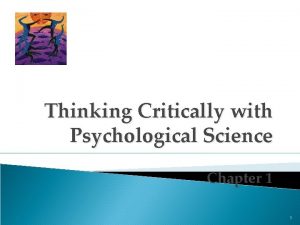Thinking Critically With Psychological Science Power Point Presentation
















































- Slides: 48

Thinking Critically With Psychological Science Power. Point® Presentation by Jim Foley © 2013 Worth Publishers

Module 2: Research Strategies: How Psychologists Ask and Answer Questions

Topics To Study Thinking flaws to overcome: § Hindsight bias § Seeing meaning in coincidences § Overconfidence error The Scientific attitude: Curious, skeptical, humble § Critical Thinking Frequently Asked Questions: § Experiments vs. real life § Culture and gender § How do we ethically study § Value judgments § Scientific Method: Theories and Hypotheses § Gathering Psych Data: Description, Correlation, and Experimentation/ Causation § Describing Psych Data: Significant Differences

Psychological Science: Overview § Typical errors in hindsight, overconfidence, and coincidence § The scientific attitude and critical thinking § The scientific method: theories and hypotheses § Gathering psychological data: description, correlation, and experimentation/causation § Describing data: significant differences § Issues in psychology: laboratory vs. life, culture and gender, values and ethics

When our natural thinking style fails: Overconfidence Hindsight bias: error: “I knew it all “I am sure I am along. ” correct. ” The coincidence error, or mistakenly perceiving order in random events: “The dice must be fixed because you rolled three sixes in a row. ”

Hindsight Bias Classic example: after watching a competition (sports, When you see most cooking), if you don’t results of You make were athis prediction accepted psychological I knew would ahead into of time, this you research, you might happen… college/university might make a say, “that was “postdiction”: “I obvious…” figured that team/person would win because…” Hindsight bias is like a crystal ball that we use to predict… the past.

Absence makes the heart grow fonder Out of sight, out of mind You can’t teach an old dog new tricks You’re never too old to learn Good fences make good neighbors No [wo]man island Birds of a feather flock together Opposites attract Seek and ye shall find These sayings But then why all do Curiosity killed the cat seemthese to make sense, other inphrases hindsight, we alsoafter seem to read makethem. sense? Look before you leap S/He who hesitates is lost The pen is mightier than the sword Actions speak louder than words The grass is always greener on the other side of the fence There’s no place like home

Hindsight “Bias” Why call it “bias”? The mind builds its current wisdom around what we have already been told. We are “biased” in favor of old information. For example, we may stay in a bad relationship because it has lasted this far and thus was “meant to be. ”

Overconfidence Error: Predicting performance § We overestimate our performance, our rate of work, our skills, and our degree of self -control. Test for this: “how long do you think it takes you to…” (e. g. “just finish this one thing I’m doing on the computer before I get to work”)? How fast can you unscramble words? Guess, then try these: HEGOUN ERSEGA Overconfidence Error: Judging our accuracy § When stating that we “know” something, our level of confidence is usually much higher than our level of accuracy. § Overconfidence is a problem in preparing for tests. Familiarity is not understanding § If you feel confident that you know a concept, try explaining it to someone else.

Perceiving order in random events: Example: The coin tosses that “look wrong” if there are five heads in a row. Result of this error: reacting to coincidence as if it has meaning Danger: thinking you can make a prediction from a random series. If there have been five heads in a row, you can not predict that “it’s time for tails” on the next flip Why this error happens: because we have the wrong idea about what randomness looks like. If one poker player at a table got pocket aces twice in a row, is the game rigged?

Making our ideas more accurate by being scientific What did “Amazing Randi” do about the claim of seeing auras? He developed a testable prediction, which would support theory if it succeeded. Which it did not. The aura-readers were unable to locate the aura around Randi’s body without seeing Randi’s body itself, so their claim was not supported.

Scientific Attitude Part 1: Curiosity Definition: always asking new questions “That behavior I’m noticing in that guy… is that common to all people? Or is it more common when under stress? Or only common for males? ” Hypothesis: Curiosity, if not guided by caution, can lead to the death of felines and perhaps humans.

Scientific Attitude Part 2: Skepticism Definition: not accepting a ‘fact’ as true without challenging it; seeing if ‘facts’ can withstand attempts to disprove them Skepticism, like curiosity, generates questions: “Is there another explanation for the behavior I am seeing? Is there a problem with how I measured it, or how I set up my experiment? Do I need to change my theory to fit the evidence? ”

Scientific Attitude Part 3: Humility refers to seeking the truth rather than trying to be right; a scientist needs to be able to accept being wrong. “What matters is not my opinion or yours, but the truth nature reveals in response to our questioning. ” David Myers

“Think critically” with psychological science… does this mean “criticize”? Critical thinking refers to a more careful style of forming and evaluating knowledge than simply using intuition. Along with the scientific method, critical thinking will help us develop more effective and accurate ways to figure out what makes people do, think, and feel the things they do. Why do I need to work on my thinking? Can’t you just tell me facts about psychology? • The brain is designed for surviving and reproducing, but it is not the best tool for seeing ‘reality’ clearly.

Consider if there are other possible explanations for the facts or results. See if there was a flaw in how the information was collected. Look for hidden assumptions and decide if you agree. Critical thinking: analyzing information, arguments, and conclusions, to decide if they make sense, rather than simply accepting it. Look for hidden bias, politics, values, or personal connections. Put aside your own assumptions and biases, and look at the evidence.

How Psychologists Ask and Answer Questions: The Scientific Method The scientific method is the process of testing our ideas about the world by: Turning our theories into testable predictions. Gather information related to our predictions. analyzing whether the data fits with our ideas. If the data doesn’t fit our ideas, then we modify our hypotheses, set up a study or experiment, and try again to see if the world fits our predictions.

Some research findings revealed by the scientific method: § The brain can recover from massive early childhood brain damage. § Sleepwalkers are not acting out dreams. § Our brains do not have accurate memories locked inside like video files. § There is no “hidden and unused 90 percent” of our brain. § People often change their opinions to fit their actions. Scientific Method: Tools and Goals The basics: § Theory § Hypothesis § Operational Definitions § Replication Research goals/types: § Description § Correlation § Prediction § Causation § Experiments

Theory: the big picture A theory, in the language of science, is a set of principles, built on observations and other verifiable facts, that explains some phenomenon and predicts its future behavior. Example of a theory: “All ADHD symptoms are a reaction to eating sugar. ”

Hypotheses: informed predictions A hypothesis is a testable prediction consistent with our theory. “Testable” means that the hypothesis is stated in a way that we could make observations to find out if it is true. What would be a prediction from the “All ADHD is about sugar” theory? One hypothesis: “If a kid gets sugar, the kid will act more distracted, impulsive, and hyper. ” To test the “All” part of theory: “ADHD symptoms will continue for some kids even after sugar is removed from the diet. ”

Danger when testing hypotheses: theories can bias our observations We might select only the data, or the interpretations of the data, that support what we already believe. There are safeguards against this: § Hypotheses designed to disconfirm § Operational definitions Guide for making useful observations: § How can we measure “ADHD symptoms” in the previous example in observable terms? § Impulsivity = # of times/hour calling out without raising hand. § Hyperactivity = # of times/hour out of seat § Inattention = # minutes continuously on task before becoming distracted

The next/final step in the scientific method: Replication Replicating research means trying the methods of a study again, but with different participants or situations, to see if the same results happen. You could introduce a small change in the study, e. g. trying the ADHD/sugar test on college students instead of elementary students.

Research Process: an example

Scientific Method: Tools and Goals The basics: § Theory § Hypothesis § Operational Definitions § Replication Research goals/types: § Description § Correlation § Prediction § Causation § Experiments Now that we’ve covered this We can move on to this

Research goal and strategy: Description Descriptive research is a systematic, objective observation of people. The goal is to provide a clear, accurate picture of people’s behaviors, thoughts, and attributes. Strategies for gathering this information: § Case Study: observing and gathering information to compile an in-depth study of one individual § Naturalistic Observation: gathering data about behavior; watching but not intervening § Surveys and Interviews: having other people report on their own attitudes and behavior

Case Study Examining one individual in depth § Benefit: can be a source of ideas about human nature in general § Example: cases of brain damage have suggested the function of different parts of the brain (e. g. Phineas Gage seen here) § Danger: overgeneralization from one example; “Joe got better after tapping his foot, so tapping must be the key to health!”

Naturalistic Observation § Observing “natural” behavior means just watching (and taking notes), and not trying to change anything. § This method can be used to study more than one individual, and to find truths that apply to a broader population.

The Survey § Definition: A method of gathering information about many people’s thoughts or behaviors through self-report rather than observation. § Keys to getting useful information: § Be careful about the wording of questions § Only question randomly sampled people Wording effects the results you get from a survey can be changed by your word selection. Example: Q: Do you have motivation to study hard for this course? Q: Do you feel a desire to study hard for this course?

What psychology science mistake was made here? Hint #2: The Chicago Tribune interviewed people about whom they would vote for. Hint #3: in 1948. Hint #1: Harry Truman won. Hint #4: by phone.

Random Sampling • If you want to find out something about men, you can’t interview every single man on earth. • Sampling saves time. You can find the ratio of colors in this jar by making sure they are well mixed (randomized) and then taking a sample. Random sampling is a technique for making sure that every individual in a population has an equal chance of being in your sample. population sample “Random” means that your selection of participants is driven only by chance, not by any characteristic.

A possible result of many descriptive studies: discovering a correlation Correlation General Definition: an observation that two traits or attributes are related to each other (thus, they are “co”related) Scientific definition: a measure of how closely two factors vary together, or how well you can predict a change in one from observing a change in the other In a case study: The fewer hours the boy was allowed to sleep, the more episodes of aggression he displayed. In a naturalistic observation: Children in a classroom who were dressed in heavier clothes were more likely to fall asleep than those wearing lighter clothes. In a survey: The greater the number of Facebook friends, the less time was spent studying.

Correlation Coefficient • The correlation coefficient is a number representing how closely and in what way two variables correlate (change together). • The direction of the correlation can be positive (direct relationship; both variables increase together) or negative (inverse relationship: as one increases, the other decreases). • The strength of the relationship, how tightly, predictably they vary together, is measured in a number that varies from 0. 00 to +/- 1. 00. Guess the Correlation Coefficients Height vs. shoe size Years in school vs. years in jail Height vs. intelligence Close to +1. 0 Close to -1. 0 Close to 0. 0 (strong positive correlation) (strong negative correlation) (no relationship, no correlation)

If we find a correlation, what conclusions can we draw from it? Let’s say we find the following result: there is a positive correlation between two variables, § ice cream sales, and § rates of violent crime How do we explain this?

Correlation is not Causation! “People who floss more regularly have less risk of heart disease. ” If this data is from a survey, can we conclude that flossing might prevent heart disease? Or that people with hearthealthy habits also floss regularly? “People with bigger feet tend to be taller. ” Does that mean having bigger feet causes height?

If self-esteem correlates with depression, there are still numerous possible causal links:

So how do we find out about causation? By experimentation Experimentation: manipulating one factor in a situation to determine its effect § Testing theory that ADHD = sugar: removing sugar from the diet of children with ADHD to see if it makes a difference § The depression/selfesteem example: trying interventions that improve selfesteem to see if they cause a reduction in depression

The Control Group • If we manipulate a variable in an experimental group of people, and then we see an effect, how do we know the change wouldn’t have happened anyway? • We solve this problem by comparing this group to a control group, a group that is the same in every way except the one variable we are changing. Example: two groups of children have ADHD, but only one group stops eating refined sugar. How do make sure the control group is really identical in every way to the experimental group? By using random assignment: randomly selecting some study participants to be assigned to the control group or the experimental group.

To clarify two similar-sounding terms… Random assignment of participants to control or experimental groups is how you control all variables except the one you’re manipulating. First you sample, then you sort (assign) Random sampling is how you get a pool of research participants that represents the population you’re trying to learn about.

Placebo effect § How do we make sure that the experimental group doesn’t experience an effect because they expect to experience it? § How can we make sure both groups expect to get better, but only one gets the real intervention being studied? Placebo effect: experimental effects that are caused by expectations about the intervention Working with the placebo effect: Control groups may be given a placebo – an inactive substance or other fake treatment in place of the experimental treatment. § The control group is ideally “blind” to whether they are getting real or fake treatment. § Many studies are double-blind – neither participants nor research staff knows which participants are in the experimental or control groups.

Naming the variables The variable we are able to manipulate independently of what the other variables are doing is called the independent variable (IV). The variable we expect to experience a change which depends on the manipulation we’re doing is called the dependent variable (DV). • If we test the ADHD/sugar hypothesis: • Sugar = Cause = Independent Variable • ADHD = Effect = Dependent Variable The other variables that might have an effect on the dependent variable are confounding variables. • Did more hyper kids get to choose to be in the sugar group? Then their preference for sugar would be a confounding variable. (preventing this problem: random assignment).

Filling in our definition of experimentation An experiment is a type of research in which the researcher carefully manipulates a limited number of factors (IVs) and measures the impact on other factors (DVs). *in psychology, you would be looking at the effect of the experimental change (IV) on a behavior or mental process (DV).

Correlation vs. causation: the breastfeeding/intelligence question • Studies have found that children who were breastfed score higher on intelligence tests, on average, than those who were bottle-fed. • Can we conclude that breast feeding CAUSES higher intelligence? • Not necessarily. There is at least one confounding variable: genes. The intelligence test scores of the mothers might be higher in those who choose breastfeeding. • So how do we deal with this confounding variable? Hint: experiment.

Ruling out confounding variables: experiment with random assignment An actual study in the text: women were randomly selected to be in a group in which breastfeeding was promoted +6 points

Summary of the types of Research Comparing Research Methods Research Basic Purpose Method Descriptive To observe and record behavior Correlational How What is Conducted Manipulated Perform case Nothing studies, surveys, or naturalistic observations To detect naturally Compute Nothing occurring statistical relationships; to association, assess how well sometimes one variable among survey predicts another responses Experimental To explore causeeffect Weaknesses No control of variables; single cases may be misleading Does not specify cause-effect; one variable predicts another but this does not mean one causes the other Manipulate The Sometimes not one or more independent possible for factors; variable(s) practical or ethical randomly reasons; results assign some to may not control group generalize to other contexts

Drawing conclusions from data: are the results useful? After finding a pattern in our data that shows a How to achieve reliability: difference between one § Nonbiased sampling: Make sure the sample that you studied is a good group and another, we representation of the population you are can ask more questions. trying to learn about. § Is the difference § Consistency: Check that the data reliable: can we use (responses, observations) is not too this result to widely varied to show a clear pattern. generalize or to § Many data points: Don’t try to generalize predict the future from just a few cases, instances, or behavior of the responses. broader population? When have you found statistically § Is the difference significant: could the significant difference (e. g. between experimental and control groups)? result have been § When your data is reliable AND caused by random/ chance variation § When the difference between the groups? is large (e. g. the data’s distribution curves do not overlap too much).

FAQ about Psychology Laboratory vs. Life Diversity Question: How can a result from an experiment, possibly simplified and performed in a laboratory, give us any insight into real life? Answer: By isolating variables and studying them carefully, we can discover general principles that might apply to all people. Question: Do the insights from research really apply to all people, or do the factors of culture and gender override these “general” principles of behavior? Answer: Research can discover human universals AND study how culture and gender influence behavior. However, we must be careful not to generalize too much from studies done with subjects who do not represent the general population.

FAQ about Psychology Ethics Question: Why study animals? Is it possible to protect the safety and dignity of animal research subjects? Answer: Sometimes, biologically related creatures are less complex than humans and thus easier to study. In some cases, harm to animals generates important insights to help all creatures. The value of animal research remains extremely controversial. Ethics Question: How do we protect the safety and dignity of human subjects? Answer: People in experiments may experience discomfort; deceiving people sometimes yields insights into human behavior. Human research subjects are supposedly protected by guidelines for non-harmful treatment, confidentiality, informed consent, and debriefing (explaining the purpose of the study).

FAQ about Psychology The impact of Values Question: How do the values of psychologists affect their work? Is it possible to perform valuefree research? Answer: Researchers’ values affect their choices of topics, their interpretations, their labels for what they see, and the advice they generate from their results. Value-free research remains an impossible ideal.
 Thinking critically with psychological science
Thinking critically with psychological science Thinking critically with psychological science
Thinking critically with psychological science Thinking critically with psychological science answer key
Thinking critically with psychological science answer key Illusory correlations ______.
Illusory correlations ______. Thinking critically
Thinking critically Power point presentation topic in hindi
Power point presentation topic in hindi Power point presentation design west vancouver
Power point presentation design west vancouver Real power formula
Real power formula Power bi power point
Power bi power point Thoughtful learning
Thoughtful learning Listening critically
Listening critically Critically appraised topic voorbeeld
Critically appraised topic voorbeeld Care of critically ill surgical patient
Care of critically ill surgical patient Nasogastrio
Nasogastrio Aseptic field
Aseptic field Critical thinking example in nursing
Critical thinking example in nursing Sonetto 27 shakespeare
Sonetto 27 shakespeare Negative issue
Negative issue General aseptic fields are managed critically
General aseptic fields are managed critically Why science is your favourite subject
Why science is your favourite subject Point point power
Point point power Module 4 the need for psychological science
Module 4 the need for psychological science Rotating snake illusion
Rotating snake illusion Positive thinking vs negative thinking examples
Positive thinking vs negative thinking examples Thinking about your own thinking
Thinking about your own thinking Analytic vs holistic thinking example
Analytic vs holistic thinking example Perbedaan critical thinking dan creative thinking
Perbedaan critical thinking dan creative thinking Thinking about you thinking about me
Thinking about you thinking about me 6 thinking hats presentation
6 thinking hats presentation Inquire crucial guarantee
Inquire crucial guarantee Criminal and addictive thinking worksheets
Criminal and addictive thinking worksheets Design thinking for data science
Design thinking for data science Science is a process of thinking
Science is a process of thinking Thinking procedurally computer science
Thinking procedurally computer science Mentovertical diameter
Mentovertical diameter Leopold maneuver
Leopold maneuver Osha 10 powerpoint
Osha 10 powerpoint Science topics for presentation
Science topics for presentation Presentation computer science
Presentation computer science Food science careers
Food science careers Science fair powerpoint presentation examples
Science fair powerpoint presentation examples Science fair powerpoint presentation examples
Science fair powerpoint presentation examples Point of view presentation
Point of view presentation The starting point in a presentation
The starting point in a presentation Solar power satellites and microwave power transmission
Solar power satellites and microwave power transmission Potential power
Potential power Flex power power supply
Flex power power supply Angular dispersive power of grating
Angular dispersive power of grating Power of a power property
Power of a power property
